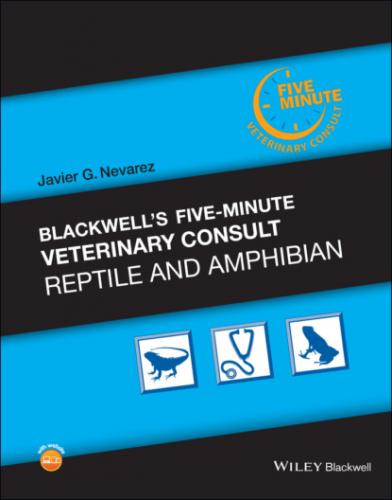COMMENTS
N/A
ZOONOTIC POTENTIAL
Viruses in the family Iridoviridae are generally temperature restricted and can only replicate at temperatures below 32 degrees C (89.6 degrees F). They are therefore unable to infect mammals or birds.
SYNONYMS
Ranavirus
ABBREVIATIONS
ELISA = enzyme‐linked immunosorbent assay
FV3 = Frog virus 3
PCR = polymerase chain reaction
POTZ = preferred optimal temperature zone
Suggested Reading
1 Allender MC, Mitchell MA, Torres T, Sekowska J, Driskell EA. Pathogenicity of frog virus 3‐like virus in red‐eared slider turtles (Trachemys scripta elegans) at two environmental temperatures. J Comp Pathol 2013;149:356–367.
2 Gray MJ, Chinchar VG, eds. Ranaviruses: Lethal Pathogens of Ectothermic Vertebrates. Heidelberg: Springer Nature; 2015.
3 Marschang RE. Virology. In: Divers SJ, Stahl SJ, eds. Mader’s Reptile and Amphibian Medicine and Surgery. St. Louis, MO: Elsevier; 2019:247–269.
Author Rachel E. Marschang, PD, Dr. med. vet., DECZM (Herpetology), FTÄ Mikrobiologie
Isospora
DEFINITION/OVERVIEW
Isospora is a genus of apicomplexan parasites with two sporocysts containing four sporozoites. Isospora is typically an intracytoplasmic parasite, but some species may have intranuclear development.
ETIOLOGY/PATHOPHYSIOLOGY
Isospora spp. have a direct life cycle, with infective stages passed in the feces of the host. Infections are confined to the intestines.
Most reports of illness associated with Isospora infection are from captive animals that have been housed under suboptimal conditions with infection often further complicated by concurrent disease.
Isospora infections are not commonly reported in chelonians.
SIGNALMENT/HISTORY
High stocking density
Unsanitary conditions
Maladaptation of wild animals entering captivity.
CLINICAL PRESENTATION
None reported, but may be related to gastrointestinal upset.
RISK FACTORS
Husbandry
Breeding colonies at high stocking density are at greatest risk.
Poor hygiene and stress are likely to predispose to infection and disease.
Others
Concurrent disease or excessive stress may cause immunosuppression, thus increasing risks of disease expression.
DIFFERENTIAL DIAGNOSIS
Other gastrointestinal disease such as bacterial or protozoal infections (i.e., Eimeria).
DIAGNOSTICS
Examination of feces for presence of oocysts using light microscopy.
Molecular techniques such as PCR may aid in species delineation but are unlikely to improve treatment efficacy or prognosis.
Protozoa may also be seen in biopsy or necropsy samples.
Fecal samples should be stored in 2–3% of aqueous (w/v) K2Cr2O7.
PATHOLOGICAL FINDINGS
Gross lesions may be mild and unapparent in many cases.
Histologically, there may be small intestinal villous atrophy with intracytoplasmic coccidia within enterocytes.
APPROPRIATE HEALTH CARE
N/A
NUTRITIONAL SUPPORT
Ensure that animals are well hydrated, especially if medicating with sulfa drugs.
In cases of anorectic animals, force-feeding with easily digestible proteins should be initiated.
Direct feeding by stomach tubing can be performed in some species.
Placement of an esophagostomy tube should be considered for chronic management.
Supportive fluid therapy should be provided.
CLIENT EDUCATION/HUSBANDRY RECOMMENDATIONS
Remove and isolate sick individuals and reduce stress by providing optimal living conditions and hygiene.
Thorough cleaning of cage to reduce environmental contamination of oocysts.
Ensure that quarantine protocols have been adopted for all new arrivals.
During quarantine, all animals should be subjected to repeated clinical and fecal examinations.
Keep stocking densities as low as possible, especially in stressful conditions such as breeding colonies.
DRUG(S) OF CHOICE
Ponazuril 30 mg/kg PO q48h for 2 treatments, or 30 mg/kg PO q24h for 4 treatments, then repeat for 2–4 treatments 2 weeks apart.
Toltrazuril 15 mg/kg PO q48h for 30 days.
Sulfadimethoxine 50 mg/kg q24h for 21 days.
Trimethoprim-sulfa 30 mg/kg daily for 5 days, then q48h until the coccidia are eliminated.
Prophylactic therapy or treatment based on the identification of Eimeria spp. alone should not be performed, to avoid development of resistance. Treatment should only be performed after an Isospora sp. has been confirmed to be causing clinical disease.
PRECAUTIONS/INTERACTIONS
Sulfa
